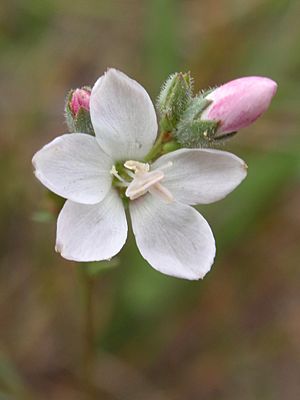Marin dwarf flax facts for kids
Quick facts for kids Marin dwarf flax |
|
|---|---|
 |
|
| Conservation status | |
| Scientific classification | |
| Genus: |
Hesperolinon
|
| Species: |
congestum
|
The Hesperolinon congestum, also known as Marin dwarf flax, is a small plant that grows for only one year. You can find it only in San Mateo, San Francisco, and Marin County, California in the United States. This plant mostly grows on special serpentine soils. It likes dry areas with native bunch grasses, chaparral, or other grasslands that are not too high up (less than 200 meters).
The flowers of the Marin dwarf flax are grouped together at the ends of its branching stems. This plant blooms between April and July. There are only about twenty small groups of these plants left. Most of these groups are not actively protected. This is a problem because the plant is listed as threatened by both federal and state governments. Sometimes, people also call this plant Marin western flax.
Contents
What Does Marin Dwarf Flax Look Like?
The stems of this wildflower are usually between five and fifteen centimeters long. Its thin leaves grow one after another along the stem. The leaves are not flat and do not wrap around the stem. The plant also has special glands that produce a red liquid.
The flower clusters are thick and dense. Each flower has five hairy sepals, which are small leaf-like parts under the petals. These sepals are about three to four millimeters long. The five petals are pink to rose-colored and spread out widely. They are between three and eight millimeters in size. Each petal has three tiny scales at its inner base. There are five stamens, which are the male parts of the flower, and they are about 5.5 to 7.0 millimeters long. The tops of the stamens, called anthers, are pink to deep purple. The flower has six ovary chambers and three whitish styles, which are part of the female reproductive system. The outside of the fruits is smooth.
How Marin Dwarf Flax Was Named
Henry Nicholas Bolander was the first person to find and describe Marin Dwarf Flax. He did this in 1863 in Marin County while working for the California Geological Survey. Later, in 1865, Asa Gray first named this new plant Linum congestum. However, in the same book, he also described it as part of a group called Hesperolinon.
It was J.K. Small who decided in 1907 that this plant should be in its own separate group, or genus, called Hesperolinon. In 1925, another scientist named Jepson thought Hesperolinon should be part of the Linum group again. He called Hesperolinon congestum a subspecies of L. californicum. But in 1961, Helen K. Sharsmith did a detailed study of Hesperolinon. Her study showed that Marin Dwarf Flax definitely deserved to be its own species and its own genus, H. congestum.
Where Marin Dwarf Flax Lives
Scientists like W.L. Jepson, Alice Eastwood, and Katharine Brandegee first found and identified this plant in the late 1800s and early 1900s. Most of these early discoveries were made in Tiburon and San Francisco. In the mid-1900s, more records of the plant appeared in San Mateo County. These were mainly in Redwood City (especially in Edgewood Park) and in San Mateo.
Protecting Marin Dwarf Flax
The State of California officially listed Marin Dwarf Flax as a threatened species in 1992. The U.S. federal government also listed it as threatened in 1995. Besides these government protections, the California Native Plant Society has also given Marin Dwarf Flax a special classification (List 1B, R-E-D Code 3-3-3ru).
In 2006, the Pacific Gas and Electric Company (PG&E) announced a plan that could harm the places where H. congestum and other protected plants live. PG&E said they might destroy or change over 500,000 acres (2,000 square kilometers) of habitat in California. Some of these areas are known homes for H. congestum. They said they would create a full report for people to review before doing anything. One part of their plan that could cause a lot of damage is using herbicides. These chemicals would kill almost all plants in large areas under power lines.
Ring Mountain in Marin County, California is one place where H. congestum grows. In fact, the only group of these plants that is actively cared for is on Ring Mountain. This mountain is a nature reserve on the Tiburon Peninsula and is managed by The Nature Conservancy.
Many other groups of Marin dwarf flax are in San Mateo County. Two of these groups near the Crystal Springs Reservoir are at risk. This is because the county wants to build a larger trail system. Also, a proposed new power line, the Jefferson-Martin 230 kV transmission line, would go through areas where Marin Dwarf Flax lives. This line would run from San Francisco to northern San Mateo County.
In 2014, a new group of Marin dwarf flax was found in Woodside. PG&E discovered it while replacing a gas pipeline. This project is destroying about 10% of this new plant group. However, a plan was created during the pipeline construction to try and fix the damage. Before this new discovery in Woodside, the California Natural Diversity Database listed 27 groups of the plant. Twelve were in Marin County, three in San Francisco (though one is gone and another had only one plant seen in 1985), and twelve in San Mateo County.


